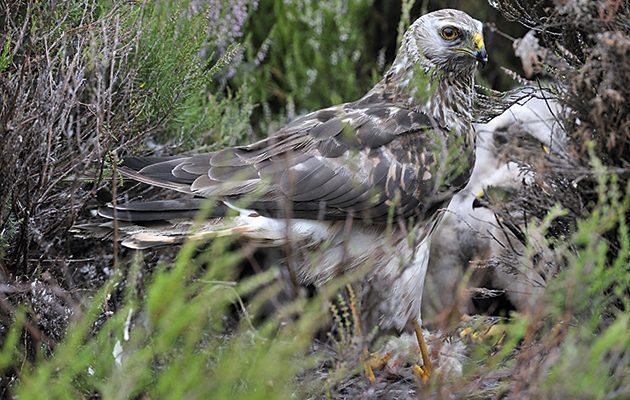Although the Langholm Moor Demonstration Project stopped short of its 10-year lifespan, it has done much to resolve conflict between raptor conservation and grouse-moor management, says Tim Baynes
Langholm Moor Demonstration Project may have stopped short of its 10-year lifespan, but to view it as a failure is to be short sighted, argues Tim Baynes.
One of Langholm’s successes was to keep all sides talking, as conservation projects are often shrouded by dispute. Rob Yorke says we must work together, in conservation conflict: ending the conflict.
LANGHOLM MOOR DEMONSTRATION PROJECT
The received wisdom is that the Langholm Moor Demonstration Project (www.langholmproject.com) has been a failure because the keepering has finished short of its 10-year lifespan, but that is to underestimate seriously the wider value of the project.
The project was set up in 2008 to resolve unanswered questions from the Joint Raptor Study between 1992 and 1997. During that study, grouse-shooting was rendered unviable by a tenfold increase in hen harriers and the subsequent withdrawal of fox and crow control led to a crash in the number of harriers and waders. However, diversionary feeding of harriers had been trialled and it seemed to be a way to limit harrier predation on grouse in the breeding season. It was felt that renewed keepering with diversionary feeding could enable enough grouse to breed again for economically viable shooting, set at 1,000 brace per year, as well as harriers in sufficient numbers to satisfy Special Protection Area targets.
The harriers were initially slow to respond but in 2013 finally exceeded their target. Grouse numbers partially recovered, almost reaching half of the target density in 2013, but then dropped back again. With the good habitat, regular fox and crow control and diversionary feeding, what was preventing grouse (and wader) recovery? The confounding factor seems to have been the overall impact of buzzards, ravens and other raptor species predating adult grouse all year round, with harriers starting to overwinter on the moor, too.
LANGHOLM MOOR DEMONSTRATION PROJECT: OBJECTIVES DELIVERED
Two of the four objectives were delivered. The hen harrier population is now in line with the SPA target and the habitat has been improved. There used to be an argument that poor grouse recovery at Langholm was caused as much by poor habitat but that has been resolved, demonstrating that you can have good habitat but still no grouse. That takes another unknown factor out of the debate. Legal predator control has been done to a high standard at the Langholm Moor Demonstration Project, leaving the impact of protected predators firmly in the spotlight. Clearly, the magic 1,000 brace shootable surplus was not achieved but the project was designed to show “whether and how” the objectives could be delivered, not necessarily to deliver them. In fact, the inability to deliver answers one key question: could economically viable grouse-shooting be re-established? It is clear from the seven-year project report that grouse numbers could not recover from low stocks and that raptor predation has accounted for 78% of adult grouse deaths at Langholm. There were 80 pairs of raptors from seven species nesting on and around the moor at the last count, excluding ravens. Everyone involved now agrees that this level of multi-species raptor predation makes grouse-shooting unviable. Demonstrating this is a vital step in making the case for action to resolve it.
The fourth objective, “demonstration of how to resolve conflicts between moorland management for raptors and red grouse”, is the most interesting. Most would say that there is still no resolution but that is not the whole story. Tribute must be paid to head keeper Simon Lester, who took on the most difficult job in grouse management and did it brilliantly. Not just the day-to-day work but a huge amount of PR and diplomacy, too. Through 35 site visits and 20 other events, an estimated 1,350 people were educated about the project; all will have appreciated his balanced approach and clarity of thought. The project partners are to be congratulated for not just parading the old arguments when the project stopped prematurely. When the project started, many people were sceptical but agreed to support it because of the urgent need to have a long-term, collaborative arena for this most difficult of debates. That faith is now paying dividends. The decision about “what next for Langholm” is obvious to the layman and no longer confused by conflicting science on the key points but, clearly, those involved have multiple considerations to balance.
LANGHOLM MOOR DEMONSTRATION PROJECT: A REAL CAUSE FOR OPTIMISM
A real cause for optimism is the very different playing field for the grouse/raptor debate in Scotland. Proven incidents of raptor persecution have dropped in the past five years to a level at which they can no longer be used as a reason not to discuss adaptive management of any species that is in good conservation status. Collaborative work at Scotland’s Moorland Forum, culminating in the year-long “Understanding Predation” research project, is now capable of achieving real dispute resolution and trust on the ground is improving, with grouse moors increasingly taking part in initiatives such as “Heads Up For Harriers” . The Langholm Moor Demonstration Project has played a big role in keeping all sides talking while these other initiatives have developed and that in itself is a massive achievement.
The facts are as clear as they are ever likely to be and there is an auspicious mood of cooperation. It is good news that Roseanna Cunningham has been appointed Minister for Environment in Scotland again, because her previous knowledge of Langholm can only help with understanding what the project outcome could mean for the future of moorland management in Scotland.
Tim Baynes is director of the Moorland Group at Scottish Land and Estates





